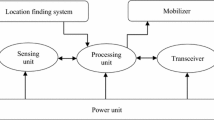Abstract
This study examines the problem that sensors are irregularly deployed in a wireless sensor network (WSN). Such irregularity makes clustering protocols less efficient. This paper proposes a new clustering algorithm, called balanced clustering algorithm (BCA), for irregularly deployed WSNs. In BCA, each node determines the probability that the node itself becomes the cluster head (CH) by considering the sensing population, which is defined as the number of nodes within the sensing range of a node. As a result, the coverage area of each cluster is distributed almost equally and unused redundant nodes are turned into sleep mode. Therefore, the large deviation of the coverage areas of clusters in a network can be decreased and the unnecessary duplication of sensing and transmission can also be decreased. In addition, the inefficient energy consumption is reduced significantly because the sleeping nodes do not send duplicated information over high populated areas. According to the simulation, the proposed BCA reduces energy consumption, increases the network lifetime and distributes the detection area of each cluster evenly, compared to the conventional schemes.











Similar content being viewed by others
References
Asaduzzaman, & Kong, H. Y. (2010). Energy efficient cooperative LEACH protocol for wireless sensor networks. Journal of Communications and Networks, 12(4), 358–365.
Akkaya, K., & Younis, M. (2005). A survey on routing protocols for wireless sensor networks. Journal of Ad Hoc Networks, 3, 325–349.
Al-Karaki, J. N., & Kamal, A. E. (2004). Routing techniques in wireless sensor networks: A survey. IEEE Wireless Communications, 11(6), 6–28.
Oh, S., Hur, S., & Lee, G. (2010). An efficient energy usage of wireless sensor network. IE Interfaces, 23(2), 108–117.
Heinzelman, W. R., Chandrakasan, A., & Balakrishnan, H. (2000). Energy-efficient communication protocols for wireless microsensor networks. Proceedings of the Hawaii International Conference on Systems Sciences, 2, 10–19.
Heinzelman, W. B., Chandrakasan, A. P., & Balakrishnan, H. (2002). An application-specific protocol architecture for wireless microsensor networks. IEEE Transactions on Wireless Communications, 1(4), 660–670.
Younis, O., & Fahmy, S. (2004). HEED: A hybrid, energy-efficient, distributed clustering approach for ad hoc sensor networks. IEEE Transactions on Mobile Computing, 3(4), 366–379.
Muruganathan, S. D., Ma, D. C. F., Bhasin, R. I., & Fapojuwo, A. O. (2005). A centralized energy-efficient routing protocol for wireless sensor networks. IEEE Radio Communications, 43(3), S8–S13.
Manjeshwar, A., & Agrawal, D. (2001). TEEN: A routing protocol for enhanced efficiency in wireless sensor networks. In Proceedings of 15th international parallel and distributed processing symposium, 2009–2015.
Manjeshwar, A., & Agrawal, D. P. (2002). APTEEN: A hybrid protocol for efficient routing and comprehensive information retrieval in wireless sensor networks. In Proceedings of international parallel and distributed processing symposium (pp. 195–202).
Kim, K. T., Lyu, C. H., Moon, S. S., & Yoon, H. Y. (2010). Tree-based clustering (TBC) for energy efficient wireless sensor networks. In Proceedings of IEEE 24th international conference on advanced information networking and applications workshop (pp. 680–685).
Kim, D.-Y., & Cho, J. (2008). A method to support mobile sink node in a hierarchical routing protocol of wireless sensor networks. Journal of the KICS, 33(1), 48–57.
Enami, N., & Moghadam, R. A. (2010). Energy based clustering self organizaing map protocol for extending wireless sensor networks lifetime and coverage. Canadian Journal on Multimedia and Wireless Networks, 1(4), 42–54.
Lee, J.-S., & Cheng, W.-L. (2012). Fuzzy-logic-based clustering approach for wireless sensor networks using energy predication. IEEE Sensors Journal, 12(9), 2891–2897.
Li, K., & Hua, K. A. (2013). Mobility-assisted distributed sensor clustering for energy-efficient wireless sensor networks. In Proceedings of 2013 IEEE global communications conference (Globecom 2013) (pp. 316–321).
Xu, L., O’Hare, G. M. P., & Collier, R. (2014). A balanced energy-efficient multihop clustering scheme for wireless sensor networks. In Proceedings of 7th IFIP wireless and mobile networking conference (WMNC 2014) (pp. 1–8).
Nguyen, L. T., Defago, X., Beuran, R., & Shinoda, Y. (2008). An energy efficient routing scheme for mobile wireless sensor networks. Wireless communication systems (pp. 568–572).
Bo, W., Hu, H.-Y., & Wen, F. (2008). An improved LEACH protocol for data gathering and aggregation in Wireless Sensor Networks. Computer and electrical engineering (pp. 398–141).
Yadav, K.R., Pal, V., Singh, G., & Yadav, R.P. (2011). Variable frame slot clustering scheme for data gathering wireless sensor networks. Nirma University International Conference (pp. 1–5).
UCB/LBNL/VINT Network Simulator - ns (Version 2). (2012). http://www.isi.edu/nsnam/ns/
Shin, H., Moh, S., & Chung, I. (2012). A balanced clustering algorithm for non-uniformly deployed sensor networks. In Proceedings of 9th IEEE international symposium on embedded computing (EmbeddedCom 2011) (pp. 343–350).
Acknowledgments
A preliminary version of this work was presented at the 9th IEEE International Symposium on Embedded Computing, December 2011 [21]. The authors wish to thank the editor and anonymous reviewers for their helpful comments for improving the quality of this paper. This work was supported in part by the research fund from Chosun University. Correspondence should be addressed to Dr. Sangman Moh (smmoh@chosun.ac.kr).
Author information
Authors and Affiliations
Corresponding author
Rights and permissions
About this article
Cite this article
Shin, H., Moh, S., Chung, I. et al. Equal-Size Clustering for Irregularly Deployed Wireless Sensor Networks. Wireless Pers Commun 82, 995–1012 (2015). https://doi.org/10.1007/s11277-014-2262-5
Published:
Issue Date:
DOI: https://doi.org/10.1007/s11277-014-2262-5




